#arab american national museum
Explore tagged Tumblr posts
Text

I'm reading tonight, online, with the Arab American National Museum.
7pm ET / midnight GMT
Free, with a suggested donation to Pal Legal and PCRF.
RSVP.
3 notes
·
View notes
Text
Meet the Arab Americans, whose heritage is a roadmap to education
Have you ever visited the Arab American National Museum or checked out their book awards, film festivals and concerts? The museum “provides people with a more authentic and real representation of what it means to be Arab American.���
“We communicate the American narrative in the voices of Arab Americans. They express their experiences in their own words,” says Diana Abouali, director of the Arab American National Museum, located in Dearborn, Michigan.
Arab immigrant stories aren’t well-known among mainstream America. And what little Americans do know about Arabs is often informed by negative stereotypes.
Arab Americans are a diverse community that come from 22 Arab countries stretching from northern Africa to western Asia. But once they settle in the U.S., the museum director says, they become as American as they are Arab.

Ralph Nader is known for his lifetime of activism and fearless critique. Yet in this fresh and inspiring book The Seventeen Traditions: Lessons from an American Childhood, Nader takes a look backward - at a serene and enriching childhood spent in bucolic Winsted, Connecticut.
In his most personal writing to date, Nader fondly describes his father’s restaurant and how it taught him about work, community, how to share in the spirit of others, along with the value of his mother’s Lebanese cooking and how it defined his relationship with his heritage.
#manchester#iraq#iraqi#london#uk#baghdad#hussein al-alak#usa#arab americans#ralph nader#arab american national museum#america#dearborn#michigan#university of michigan#education#learning#higher education#schools#heritage#history#culture#women in history
6 notes
·
View notes
Text
"Gardening can help immigrant and refugee communities supplement their pantries by growing their own culturally appropriate food that isn’t found in grocery stores. Two community garden projects in Michigan create connections for those communities."
#PBS NewsHour#PBS#Community Gardens#Helping Refugees#Helping Immigrants#Al-Hadiqa (Arabic for “the garden”)#Garden Juju Collective#Cultivating New Beginnings#Cultivate & Grow Oral Histories project#ACCESS Hope House#Arab American National Museum
0 notes
Text






This is definitely a trend for the hateful, christofascist, religious reich. Hobby Lobby did the same thing at previous Super Bowls.


It’s right wing, Islamophobic, homophobic, anti-abortion Christian nationalism, masquerading as “caring” religion.

The Servant Foundation: the power behind the ads
The $20 million "He Gets Us" campaign about Jesus - is funded by an influential donor to some of the most active and litigious Shadow Network groups working to undermine church-state separation.
The Servant Foundation
The Servant Foundation, also known as The Signatry, is behind the “He Gets Us” ad campaign that debuted during the 2023 Super Bowl. Over the next three years, the Servant Foundation plans to spend “about a billion dollars” toward this public relations campaign. They’ve hired a PR firm to address, in the firm’s words, the problem of “How did the world’s greatest love story in Jesus become known as a hate group?”
Of course, they’re the cause of their own problem – not only has the Servant Foundation funded hate groups, but the PR firm, Haven, has represented these organizations. Key Shadow Network members Focus on the Family and Alliance Defending Freedom are in their portfolio. ADF is a noted anti-LGBTQ hate group that has argued repeatedly in courts that religion, and specifically Christianity, is a license to discriminate; they have one such case pending before the Supreme Court right now.
The money trail
The Servant Foundation is one of ADF’s biggest financial backers. A recent exposé reports that, “between 2018-20, the Servant Foundation donated more than $50 million to the Alliance Defending Freedom and that those contributions “were among the five largest donations given out by the foundation in each of those three years.”
Other recipients of the Servant Foundation’s billion dollars in assets include:
Nearly $8 million went to Answers in Genesis, creationist Ken Ham’s fundamentalist ministry behind the Creation Museum and Ark Encounter, an organization that has been championed by Speaker of the House Mike Johnson, a former ADF attorney.
Over $1 million was designated for the anti-LGBTQ Campus Crusade for Christ (rebranded as “Cru” since 2011).
$374,800 went to Al Hayat Ministries, an organization that seeks to “respectfully yet fearlessly unveil the deception of Islam,” and runs an Arabic-language Christian satellite TV station with the goal of converting Muslims to Christianity.
In 2020 alone, we found donations to prominent Shadow Network members American Center for Law and Justice, First Liberty Institute, and Liberty Counsel.
(continue reading)
#politics#super bowl#republicans#christian nationalism#lgbt#homophobia#christofascism#religious reich#lgbtq#jesus gets us#the servant foundation#no hate like christian love#the signatry#alliance defending freedom#adf
190 notes
·
View notes
Note
Hello! rly appreciating your posts, in particular the ones about GLAM... it made me curious if you or your followers happen to have any resources/literature to recommend on 2 areas of interest?:
1. Relating salvage anthropology to modern day ideas of trauma porn
2. Palestinian-led museums/archives/oral history projects/other collections or exhibitions of note. (Or if not literature, any names involved besides the few I know of like POHA/the nakba archive/the arab resource center for popular arts; the palestine museum; librarians & archivists with Palestine; activestills; forever our land; and art for gaza)
Anyway, again, thanks for all the time/work you’re putting into analysis and info dissemination <3
hello, thanks for sending this in. sooo i have like. no idea about the first one haha but i have so many for the second one.
The Institute for Palestine Studies has a bunch of scholarly articles and anaylsis about Palestine
Librarians and Archivists for Palestine is not completely Palestinian led but it's one that I'm a part of and really like, even though you already mention it.
The Palestine Museum Digital Archive is an AMAZING resource led by Palestinians in Palestine. I recommend scrolling through their intifada posters, downloading them, printing them, and hanging them around town.
The Palestinian Oral History Archive project in case people were wondering what POHA is.
The Museum of the Palestinian People in DC is really great and has a lot of digitized features.
The Palestine Museum US has a lot of books as well, based on Turtle Island.
The Arab American National Museum is not Palestinian led but I can vouch that they're a great group.
The Met has a lot of Palestinian clothing BUT.... warning in that it is very colonial in its arrangement and description and we dont super know how people got the material they have. If you want to look at the content feel free, though. Will say that Wafa Ghnaim, one of the leading experts on Tatreez in Turtle Island is working on recataloguing the Palestinian collection.
Visualizing Palestine is an infographic organization that might interest you.
The Nakba Archive for people wanting to check it out.
The Library of Congress is. Honestly it's pretty racist but it does have content if you wanna look at it.
Tirazain is a tatreez pattern library that's really cool.
There might be more that I'm forgetting but here are some just from me sitting here thinking for the past few minutes. If anyone else has any recommendations, feel free to add.
226 notes
·
View notes
Text
Excerpt from this story from EcoWatch:
In 1979, when President Jimmy Carter famously unveiled 32 solar panels on the White House roof, he remarked, “A generation from now, this solar heater can either be a curiosity, a museum piece, an example of a road not taken or it can be just a small part of one of the greatest and most exciting adventures ever undertaken by the American people.”
Despite his reputation as an often ineffective president, he had an enormous effect on the environment as an advocate for clean energy, protecting lands and regulating toxic chemicals.
Jimmy Carter was an early adopter of clean energy in an effort to reduce U.S. reliance on foreign oil following the oil crisis that preceded his presidency. Four years before Carter took office, the member nations of the Organization of Arab Petroleum Exporting Countries placed an oil embargo on the U.S. and several other western nations in response to their support of Israel during the Yom Kippur War. As a result, the price of oil rose by more than 300%, while American dependence on foreign oil was simultaneously rising.
After Carter took office, he responded by creating the U.S. Department of Energy. One of Carter’s major goals for the agency was to reduce the country’s dependence on fossil fuels by pushing for the domestic production of energy. While this push wasn’t perfect — part of his solution for the complex crisis included propping up domestic coal power — it was also a first-of-its-kind endorsement for clean energy, championing sustainable sources like solar and nuclear. “No one can embargo the sun,” Carter once said. “No cartel controls the sun. Its energy will not run out. It will not pollute our air or poison our waters. The sun’s power needs only to be collected, stored and used.”
In 1979, a second oil crisis hit, this time spurred by the decline in oil trade in the wake of the Iranian Revolution. Carter responded by laying out plans to expand renewable energy sources and made a pledge that 20% of American energy would be produced by renewable sources by 2000, but was voted out of office before many of these plans could come to fruition.
Carter also protected far more land than any U.S. president in history. In 1978, he advocated for the National Interest Lands Conservation Act (ANILCA,) which aimed to protect vast amounts of Alaskan wilderness from commercial use and destruction. After the bill failed due to a last-minute filibuster, Carter used executive authority to protect more than 56 million acres of Alaskan wilderness, designating those lands as National Monuments. This action alone would more than double the size of the National Park system.
In December of 1980, roughly six weeks before Carter left office, ANILCA was debated again in Congress, and passed. Upon Carter’s signature, the law became the most expansive federal protection of American lands in history, granting protection to more than 157 million acres of Alaskan wilderness, which included further protections for much of the land Carter had protected two years prior. Of those 157 million acres, it also designated nearly ten million acres to the National Wildlife Refuge System, more than nine million acres to the Wilderness Preservation System, and more than three million acres to the National Forest System.
20 notes
·
View notes
Text
Winning the World’s Hearts and Minds
Israel is losing (some even say she has already irrevocably lost) the information war that is being waged in parallel with the kinetic one that she has been engaged in since 1948, but especially since 7 October 2023. The usual suggestions are technical: spend more money, react more quickly to enemy propaganda, utilize social media more effectively, and so on. All of these are worth doing, but there is one factor that is even more important than all of them together, and it is both simpler and more difficult. There are four paradoxes that can be found in our situation that expose it.
The Paradox of 7 October
On that day, Israel was attacked in the most atavistic, brutal and vicious way that can be imagined. Civilians were murdered, raped, sadistically tortured, and carried off to indefinite captivity under subhuman conditions. Their homes were looted and burned. It was war as practiced before the advent of civilization. It was the greatest mass murder of Jews since the Holocaust.
And yet, although there were many expressions of sympathy, both from people in general and from governments and international organizations, there was also an explosion of hatred for Israel as a nation and for Jews as individuals. Demonstrations were held around the world expressing support for the attackers, and incidents of Jew-hatred – beatings of Jews, anti-Jewish graffiti, attacks on Jewish-owned businesses, and so on spiked. How is this to be understood?
One answer is that people were primed by a decades-long campaign by the Soviet Union, both in the West and the Third World, to use anti-Zionism as a propaganda tool. The Soviets took advantage of the sensitivity that had developed in the West after (ironically) the racist persecution of Jews by the Nazis, and of the general recognition of the evils of the Western colonial empires. At the same time in America, people began to comprehend the horrors of slavery, Jim Crow, and the genocide of Native Americans. The struggle of the Jews for self-determination in their historic homeland was perversely portrayed as racism, colonialism, and now even genocide. The Palestinian Arabs, who were in fact invaders and migrants, were portrayed as an oppressed and colonized indigenous people. This inversion of reality, this “big lie,” was fed with a constant tsunami of propaganda that overwhelmed anemic Israeli attempts to refute or counteract it. The lies have always gone halfway around the world before the truth got its pants on.
Since the fall of the USSR, the campaign has been taken up by the Arabs, Iranians, and international Left who see Israel as an outpost of the hated USA.
The anti-Israel campaign has been disingenuously claimed to be “only anti-Zionist” and not anti-Jewish. But underneath the surface the message has been transmitted clearly and distinctly, and has triggered the closeted anti-Jewish hatreds that have been around at least since the year zero. It is not possible today to go back and undo this.
The way anti-Israel and anti-Jewish propaganda has been deployed in support of the desired genocide of the Jewish people (nothing less) is a triumph of social engineering. Its effectiveness is shown by the combination of murder and defamation that characterized 7 October.
The Paradox of Holocaust Education
In planning a response to anti-Jewish propaganda it’s necessary to consider the attempts to attack the anti-Jewish memes – the prejudices, stereotypes, conspiracy theories, and so on – that were supposed to have caused the Holocaust. One response has been to educate people by presenting the historical facts. Any normal person who knew the true dimensions of the horror perpetrated by the Nazis would reject the patterns of thought that were behind it and shun anyone trying to promulgate them, it was reasoned.
Much money and resources have gone into the building of museums, the development of curricula and materials, and the hiring of experts. And yet this enterprise has failed. It has been met with denial. It has aroused resentment, as Jews are accused of trying to “monopolize oppression,” or of using their own experience as an excuse to persecute others (sometimes at the same time as the Jewish experience is denied). Perversely, the very horror of the Holocaust is titillating to Jew-haters who often admire Hitler, collect Nazi regalia, and so on. Extreme Jew-haters see the Holocaust as something to be repeated rather than condemned.
The Paradox of Sympathy
This gives us a clue to the more general problem of defamation of Israel and Jews. As Jonathan Haidt argues persuasively, humans are primarily motivated by their emotions, even when they believe that they are making decisions on a rational basis. The “reasoning” is really after-the-fact rationalization of choices driven by their feelings. These feelings are often below the surface of consciousness, but they are dominant in a person’s decision-making.
These emotional responses have developed in humans after millennia of biological and cultural evolution. They vary to some extent between cultures (which leads to interesting questions about conflicts between Western and non-Western cultures), but there are also aspects that are universal. One of these is sympathy for an injured person. Paradoxically, there is also an opposite emotion of revulsion. The impulse to despise, to expel, or to flee from a defective or persecuted individual tends to favor survival of an individual or a culture, and so it is strengthened by evolution. We see this tendency among children where a bully that attacks a weak or “different” child is often joined by others.
Thus when a group is mass-murdered, along with sympathy for the victims there is also a tendency to side with the murderers. There is a feeling of safety in the face of horror that comes from the knowledge that one is set apart from the victims, that one is on the other side.
The Paradox of Strength
Another evolutionary trait is an attraction to the stronger side in any conflict. Everybody loves a winner, or as Osama bin Laden said, the “strong horse.” It’s also true that people despise a loser. And before a contest is decided, people choose whom to support based on the perceived strength of each opponent.
Yet in Western cultures people think this feeling should be suppressed. There is a belief that rational considerations and morality should override brute strength in determining the outcome of a confrontation, which results in conflicting emotions (this is one of the reasons they do so poorly when negotiating with Middle Easterners, who see “rational” willingness to compromise as weakness). Strength and honor are of primary concern in the Middle East, but even toward the West, we gain allies by demonstrating strength.
How to Win the Information War
What are the practical lessons for Israel in all this? How can she use the consequences of human and societal evolution to help her overcome the massive propaganda assault, both in the West and in the Middle East? I will offer some suggestions for how she can behave for the best psychological effect. Note that I said “behave,” and not just talk. Actions speak louder than words, especially in the Middle East. And these actions will help bring success in the physical arena as well.
1. Win the War in Gaza
We were humiliated and wounded – from a psychological point of view, critically – on 7 October. We cannot allow Hamas to remain in power and its leaders to remain alive. If we do, we will be marked as victims, in other words, targets. In the Middle East, deterrence comes from honor. If we lose our honor, everything we have is open for the taking.
2. Win the War in the North
Tens of thousands of Israelis have been forced to vacate their homes in fear of bombardment and invasion by Hezbollah. In effect we have allowed our land to become occupied. Again this is a massive loss of honor and must be corrected.
3. Our Lives are More Important Than Theirs
Israel lives in fear of the US and the hostile “international community” of anti-Israel NGOs and institutions, and goes to extreme lengths to warn civilians before attacking military targets, and to allow humanitarian aid to be provided to enemy populations. These policies have made it possible for Egypt to refuse to accept refugees from Gaza, and for Hamas to prolong the conflict, arguably resulting in more civilian suffering than less. Either way, they signify weakness. Get it over with.
4. Return to an Offensive Strategy
Israeli strategy, as propounded by David Ben Gurion, was to take the war to the enemy, fight on his territory, and finish wars quickly. But since Israel has allowed the US to dominate its military policy, she has moved to adopting a defensive posture. Huge amounts of money are spent on weapons like Iron Dome to bat away enemy rockets. This is economically unsustainable, since offensive weapons are much cheaper. It invites the enemy to learn lessons and try again. And from a psychological standpoint, it normalizes shooting at Jews. How can we permit that to become acceptable?
5. Responses Should Always be Disproportionate
Israel’s response should always be several times stronger than our enemies’ provocations. The fact that we responded to an attack from Iran by hundreds of missiles and drones by bombing a radar station was embarrassing, even if it was a demonstration of our capabilities. We may wish to demonstrate capabilities, but we must also demonstrate the will to fight. Deterrence means making them afraid to attack us. Power means hitting back at bullies, not trying to push them away or running from them.
6. Treat the Conflict as Zero-Sum (it is)
Do not look for win-win situations; there aren’t any. Either the Land of Israel will be ruled and populated by Jews, or by Arabs. Americans love the idea that Hamas or the PLO can put aside their desire to destroy Israel if only given an opportunity to develop a prosperous state. Nothing could be more wrong. This is a tribal conflict over land, and tribalism is another evolutionary “built-in.” When Israel goes along with these fantasies, she broadcasts weakness.
7. Get Revenge When Appropriate
Implement the death penalty for terrorist murder. This has the practical benefit of removing a motive for hostage-taking. The modern position is that revenge is atavistic and wrong. But it satisfies a deep need as well as sending a necessary message.
Conclusion
Acting according to the post-WWII Western conception of moral national behavior exposes Israel to depredations by its enemies who do not care about Western morality. At the same time, the climate of opinion that has developed over decades is such that the mechanisms and institutions that might protect a Western state don’t apply to Israel. She has little to lose by changing her behavior to become more aggressive, and aspiring to respect and even fear. Overall this will improve her potential to gain allies and deter enemies.
32 notes
·
View notes
Text

[Eleanor Roosevelt with the Universal Declaration of Human Rights, courtesy of the FDR Presidential Library & Museum, via Wikipedia Commons]
* * * *
LETTERS FROM AN AMERICAN
December 10, 2024
Heather Cox Richardson
Dec 10, 2024
Today is Human Rights Day, celebrated internationally in honor of the day seventy-six years ago, December 10, 1948, when the United Nations General Assembly announced the Universal Declaration of Human Rights (UDHR).
In 1948 the world was still reeling from the death and destruction of World War II, including the horrors of the Holocaust. The Soviet Union was blockading Berlin, Italy and France were convulsed with communist-backed labor agitation, Greece was in the middle of a civil war, Arabs opposed the new state of Israel, communists and nationalists battled in China, and segregationists in the U.S. were forming their own political party to stop the government from protecting civil rights for Black Americans. In the midst of these dangerous trends, the member countries of the United Nations came together to adopt a landmark document: a common standard of fundamental rights for all human beings.
The United Nations itself was only three years old. Representatives of the 47 countries that made up the Allies in World War II, along with the Byelorussian Soviet Socialist Republic, the Ukrainian Soviet Socialist Republic, and newly liberated Denmark and Argentina, had formed the United Nations as a key part of an international order based on rules on which nations agreed, rather than the idea that might makes right, which had twice in just over twenty years brought wars that involved the globe.
Part of the mission of the U.N. was “to reaffirm faith in fundamental human rights, in the dignity and worth of the human person, in the equal rights of men and women and of nations large and small.” In early 1946 the United Nations Economic and Social Council organized a nine-person commission on human rights to construct the mission of a permanent Human Rights Commission. Unlike other U.N. commissions, though, the selection of its members would be based not on their national affiliations but on their personal merit.
President Harry S. Truman had appointed Eleanor Roosevelt, widow of former president Franklin Delano Roosevelt and much beloved defender of human rights in the United States, as a delegate to the United Nations. In turn, U.N. Secretary-General Trygve Lie from Norway put her on the commission to develop a plan for the formal human rights commission. That first commission asked Roosevelt to take the chair.
“[T]he free peoples” and “all of the people liberated from slavery, put in you their confidence and their hope, so that everywhere the authority of these rights, respect of which is the essential condition of the dignity of the person, be respected,” a U.N. official told the commission at its first meeting on April 29, 1946.
The U.N. official noted that the commission must figure out how to define the violation of human rights not only internationally but also within a nation, and must suggest how to protect “the rights of man all over the world.” If a procedure for identifying and addressing violations “had existed a few years ago,” he said, “the human community would have been able to stop those who started the war at the moment when they were still weak and the world catastrophe would have been avoided.”
Drafted over the next two years, the final document began with a preamble explaining that a UDHR was necessary because “recognition of the inherent dignity and of the equal and inalienable rights of all members of the human family is the foundation of freedom, justice and peace in the world,” and because “disregard and contempt for human rights have resulted in barbarous acts which have outraged the conscience of mankind.” Because “the advent of a world in which human beings shall enjoy freedom of speech and belief and freedom from fear and want has been proclaimed as the highest aspiration of the common people,” the preamble said, “human rights should be protected by the rule of law.”
The thirty articles that followed established that “[a]ll human beings are born free and equal in dignity and rights…without distinction of any kind, such as race, colour, sex, language, religion, political or other opinion, national or social origin, property, birth or other status” and regardless “of the political, jurisdictional or international status of the country or territory to which a person belongs.”
Those rights included freedom from slavery, torture, degrading punishment, arbitrary arrest, exile, and “arbitrary interference with…privacy, family, home or correspondence, [and] attacks upon…honour and reputation.”
They included the right to equality before the law and to a fair trial, the right to travel both within a country and outside of it, the right to marry and to establish a family, and the right to own property.
They included the “right to freedom of thought, conscience and religion,” “freedom of opinion and expression,” peaceful assembly, the right to participate in government either “directly or through freely chosen representatives,” the right of equal access to public service. After all, the UDHR noted, the authority of government rests on the will of the people, “expressed in periodic and genuine elections which shall be by universal and equal suffrage.”
They included the right to choose how and where to work, the right to equal pay for equal work, the right to unionize, and the right to fair pay that ensures “an existence worthy of human dignity.”
They included “the right to a standard of living adequate for…health and well-being…, including food, clothing, housing and medical care and necessary social services, and the right to security in the event of unemployment, sickness, disability, widowhood, old age or other lack of livelihood in circumstances beyond [one’s] control.”
They included the right to free education that develops students fully and strengthens “respect for human rights and fundamental freedoms.” Education “shall promote understanding, tolerance and friendship among all nations, racial or religious groups, and shall further the activities of the United Nations for the maintenance of peace.”
They included the right to participate in art and science.
They included the right to live in the sort of society in which the rights and freedoms outlined in the UDHR could be realized. And, the document concluded, “Nothing in this Declaration may be interpreted as implying for any State, group or person any right to engage in any activity or to perform any act aimed at the destruction of any of the rights and freedoms set forth herein.”
Although eight countries abstained from the UDHR—South Africa, Saudi Arabia, and six countries from the Soviet bloc—no country voted against it, making the vote unanimous. The declaration was not a treaty and was not legally binding; it was a declaration of principles.
Since then, though, the UDHR has become the foundation of international human rights law. More than eighty international treaties and declarations, along with regional human rights conventions, domestic human rights bills, and constitutional provisions, make up a legally binding system to protect human rights. All of the members of the United Nations have ratified at least one of the major international human rights treaties, and four out of five have ratified four or more.
Indeed, today is the fortieth anniversary of the U.N.’s adoption of the Convention Against Torture and Other Cruel, Inhuman or Degrading Treatment or Punishment, more commonly known as the United Nations Convention Against Torture (UNCAT), which follows the structure of the UDHR.
The UDHR remains aspirational, but it is a vital part of the rules-based order that restrains leaders from human rights abuses, giving victims a language and a set of principles to condemn mistreatment. Before 1948 that language and those principles were unimaginable.
In a proclamation today, the White House recommitted to “upholding the equal and inalienable rights of all people.” It noted that in the U.S., the Biden administration established “the White House Gender Policy Council to advance the rights and opportunities of women and girls across domestic and foreign policy [and] rejoined the United Nations Human Rights Council to highlight and address pressing human rights concerns.” It has “worked to protect the rights of LGBTQI+ people” and to expand “accessibility for people with disabilities.” Crucially, the administration has also worked to stop the misuse of commercial spyware, which has enabled human rights abuses around the world as authoritarian governments surveil their populations, and to fight back against transnational repression targeting human rights defenders.
At the State Department, Under Secretary of State Uzra Zeya, Assistant Secretary of State Dafna Rand, and Secretary of State Antony Blinken honored eight individuals with the Human Rights Defender Award. The recipients came from Kuwait, Bolivia, the Kyrgyz Republic, Burma, Eswatini, Ghana, Colombia, and Azerbaijan and defend migrant workers, LGBTQ+ individuals, women, democracy.
Their stories underlined both that the fight for human rights is universal and that it requires courage. One recipient’s award was delivered in absentia because he is imprisoned. Another award was posthumous—the recipient was murdered last year.
LETTERS FROM AN AMERICAN
HEATHER COX RICHARDSON
#Human rights#Letters from An American#heather cox richardson#state department#women#UDHR#history#American History#FDR
10 notes
·
View notes
Text
palestinian poets: george abraham
george abraham (they/he/هو) is a palestinian american poet, performance arist, and writer who was born and raised on unceded timucuan lands (jacksonville, FL). their debut poetry collection birthright (button poetry) won the arab american book award and the big other book award, and was a lambda literary award finalist. he is also the author of the chapbooks al youm and the specimen's apology. their collaborations include co-editing a palestinian poetry anthology with noor hindi (haymarket books, 2025), and a performance art project titled EVE with fargo nissim tbakhi.
they are a recipient of fellowships from kundiman, the arab american national museum, the boston foundation, the national performance network, and the MAP fund, and more. their writing has appeared in poetry magazine, the nation, the american poetry review, guernica, the baffler, the paris review, mizna, and many other journals and anthologies. a graduate of swarthmore college and harvard university, they have taught at emerson college, and are currently a litowitz MFA+MA candidate in poetry at northwestern university. he is also currently executive editor of the whiting award-winning journal mizna.
you can follow them on twitter @IntifadaBatata.
IF YOU READ JUST ONE POEM BY GEORGE ABRAHAM, MAKE IT THIS ONE
OTHER POEMS ONLINE THAT I LOVE BY GEORGE ABRAHAM
Field Notes on Terror & Beginnings at poetry daily
Love Letter to the Eve of the End of the World at the margins
Of Nation, at rusted radishes: beirut literary and art journal
Searching for a Palestinian After at the nation
Stage Directions for a Representation in which Eve and Adam travel through their first checkpoint at mosaic theatre company
the ghosts of the dead sea are rising at the drift
ars poetica in which every pronoun is FREE PALESTINE at the margins
“from UNIVERSAL THEORY IN WHICH EVERY FAILED ATTEMPT AT LOVE IS A SOULMATE FROM AN ALTERNATE TIMELINE” at fiyah literary magazine
Ode to My Swollen, Mono-Infected Spleen at brooklyn poets
The Olive Tree Speaks of Deforestation to my body at crabfat magazine
arab/queer vs. Imaginary at shade literary arts
self-portrait with second-degree sunburn at
[ summer / winter ] is the worst time to lose a [ country / lover ] at wildness
maqam of moonlight, for the wandering at the rumpus
against perturbation at the scores
apology, at cordite poetry review
i also adore this 2021 essay of abraham's at guernica magazine called teaching poetry in the palestinian apocalypse: towards a collective, lyric "i".
55 notes
·
View notes
Text
by Michael Lee
A crowd of rallygoers in Dearborn, Michigan, waved flags in support of Lebanon and chanted "Death to Israel" in an event attended by Dearborn Mayor Abdullah Hammoud, while at another rally participants chanted a common threat against Jews.
Multiple events in Dearborn, a suburb west of Detroit, over the last few weeks have highlighted the growing resentment for Israel in the city as Vice President Kamala Harris attempts to shore up support among a fragile coalition in the vital swing state of Michigan.
Hammoud, the city’s mayor, spoke at a Sept. 25 rally in support of Lebanon and slain Hezbollah leader Hassan Nasrallah, which featured chants of "Death to Israel" and demands for Jews to be returned "back to Poland."https://39706483df4fecc4aef910aca3846548.safeframe.googlesyndication.com/safeframe/1-0-40/html/container.html?n=0
"The reality is, they wish for us to divide ourselves," Hammoud said at the rally, video of which was reported on by the Middle East Media Research Institute (MEMRI). "But my message is very clear. The values which we advocate for here in Dearborn, we understand, we not only want for the people within the city of Dearborn, but for the people across this globe."

Pro-Palestinian demonstrators protest outside the Arab American National Museum in Dearborn, Michigan, on Aug. 11, 2024. (Jeff Kowalsky/AFP via Getty Images)
Community leader Osama Siblani helped lead the event, MEMRI reported, introducing Hammoud as "the greatest mayor in the United States of America," and later praised Nasrallah, the former secretary-general of Hezbollah who was killed in an Israeli airstrike last month.
"Our martyrs are heroes, our leaders are great," Siblani said, according to a MEMRI translation of the video. "And first among them, their leader, the great Sayyed, Hassan Nasrallah."
#dearborn#dearborn michigan#hezbollah#support for terror#hassan nasrallah#kamala harris#osama siblani#memri#abdullah hammoud
9 notes
·
View notes
Text
Playing Card Master Infodump
Ok gang, let's talk about playing cards again.
I’m going to try and get through this as systematically as possible but I will inevitably end up repeating myself due to the interconnected nature of the whole thing. Also I’ll try putting in subheadings to make it more readable. Let’s crack on!
Mameluk Playing Cards
I mentioned in my first post that European playing cards are based on ones from Mameluk Egypt, so let’s see if we can find some historical examples.

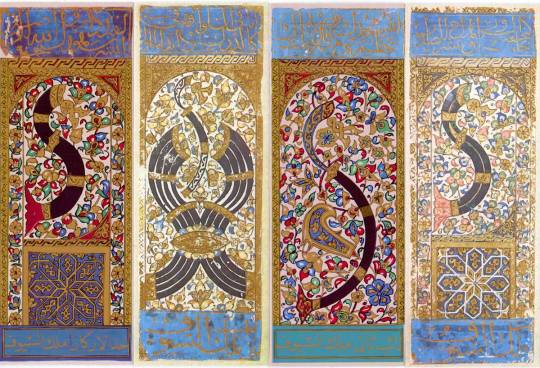
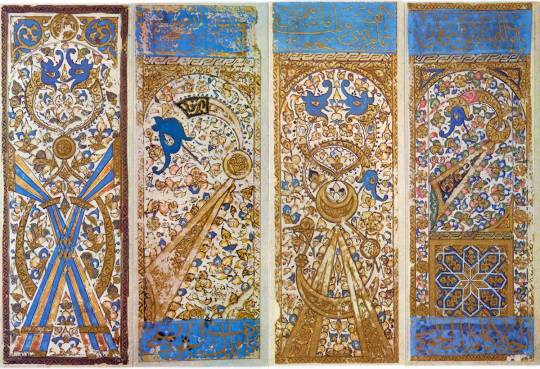

From the Topkapu Sarayi Museum in Istanbul, an amazingly preserved set of Mameluk playing cards depicting the four suits
These cards are a perfect starting point. Dating from the 15th or 16th century, we’ll be seeing their influence percolate throughout playing card design throughout Europe. Here we see the suits that will directly influence Spanish and Italian playing cards: coins, cups, swords, and polo batons (a common sport of the ruling class). The court cards are King-Lieutenant-Second Lieutenant, the deck would’ve contained 52 cards (1-10 plus three court cards), and the illustrations are rich in detail and heavy with Islamic calligraphy. We will be tracing the evolution of European cards back to these ones as we go along, so it’s important to have an example of where it all started.
Spanish Patterns
The Islamic influence in southern Spain makes it the perfect entry point for playing cards to arrive in European material culture around the late 14th century. Spanish patterns follow the same suits as Mameluk ones (coins, cups, swords, and staffs), but a deck would contain only 48 cards, numbers 1-9 and three court cards. The court cards follow the Mameluk rankings but with a European twist, making it King-Knight-Page. Swords in Spanish cards are depicted straight, as opposed to Italian swords which are curved.

Old Catalan / Spanish National Pattern, modern day
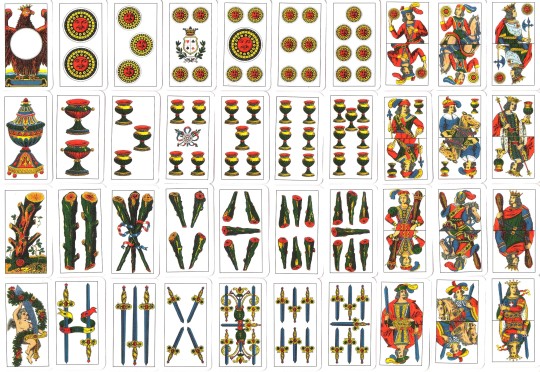
Piacentine Pattern, found in Italy in Bourbon ruled Piacenza, shows remarked Spanish influence yet is the only Spanish pattern regularly sold today to feature reversible court cards
Some syncretism would occur with the intermediary Franco-Spanish pattern, as Spanish cards would arrive in France prior to the establishment of the French standard patterns. The use of Spanish suited cards continues in areas such as Brittany and the Vendee through the game of Aluette, however the original Franco-Spanish pattern is now extinct. These decks would also consist of 48 cards: 1-9 and three court cards, King-Knight-Page (Roi-Cavalier-Valet). The use of these patterns would directly influence French patterns to come
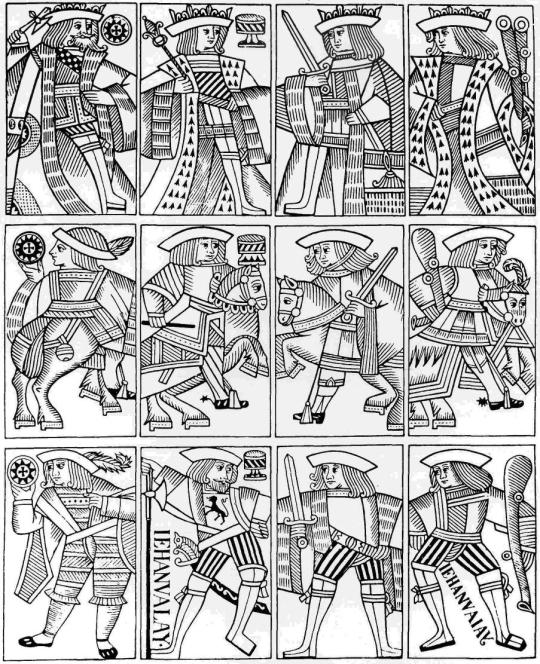
The court cards in the Franco-Spanish pattern showing Spanish suits
French Patterns
French patterns would begin with Spanish ones around the 14th Century, and would mesh with Germanic ones to produce something we would start to recognise as the Anglo-American pattern. The French suits (Hearts, Clovers (Clubs), Tiles (Diamonds), and Pikes (Spades)) are based on the Germanic suits (Hearts, Acorns, Bells, and Leaves respectively), however for a brief period a suit of Crescents was used instead of Tiles.
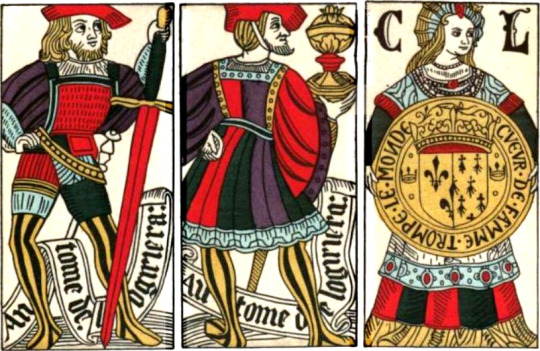
Cards celebrating the union of the kingdoms of Britanny and France, 1500, show the Spanish suits
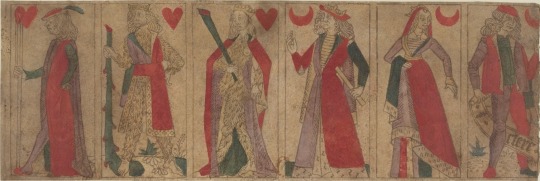
An example of the short-lived Crescents suit, Lyon, late 15th century
The majority of Italian, Spanish, and Germanic patterns follow the Mameluk tradition of all male court cards, which causes French patterns to stand out with the inclusion of Queens in place of the Knights. Queens had appeared in decks in both Italy and Germany in the 15th century, but had mostly been dropped in non-tarot decks. The inclusion of Queens, however, continued in France where their inclusion replaced the Cavalier (Knight) with the Dame (Queen). The naming convention of Dame for Queen will also be seen in Germanic patterns.
The Paris pattern, as distinct from Anglo-American or Hamburg patterns (about which more anon), is unique in that each of the court cards reference a historical or biblical figure, and are so named even to this day in the portrait officiel pattern (a deck of 32 cards, however sometimes printed in 52-card deck variants). As an example, the Kings of the Paris pattern refer to Charlemagne (Hearts), Alexander the Great (Clovers), Julius Caesar (Tiles), and King David (Pikes). The use of Julius Caesar as the historical figure associated with the King of Tiles, and most known in the past by his depiction on Roman coins in profile, might explain why in the later Anglo-American pattern the King of Diamonds is the only King to be depicted standing in profile.
Belgian pattern cards are similar to Paris (portrait officiel) decks and likewise come in 32-card and 52 card variants.
Germanic patterns
The closest pattern to connect Germanic decks to French ones is the Hamburg pattern, which would directly influence the North German or Berlin pattern. Taking the suits that we know today (hearts, clubs, diamonds, spades) and beginning production in the early 19th century, a clear link to the Paris (portraits officiel) pattern is shown in the depiction of the King of Spades holding the Harp of King David, a reference to the association of King David with the suit of Pikes (Spades) in the Paris pattern, and the laurel wreath under the crown of the King of Diamonds (Julius Caesar, King of Tiles). Germanic patterns closely associated with the French patterns name the court cards as King-Lady-Farmer (König-Dame-Bauer)
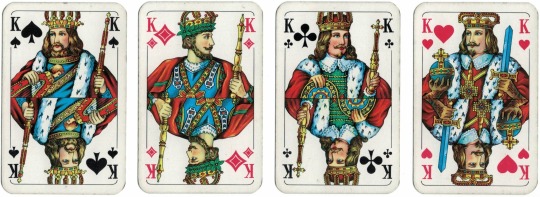
The Kings from the North German pattern showing links to the Paris (portrait officiel) pattern conventions
Germanic pattern playing cards, however also predate the suits used in French patterns and had a direct influence on them. The Germanic suits of Hearts, Acorns, Bells, and Leaves became standard around 1450, where upon it would directly influence the French suits and finally the modern Anglo-American system of Hearts, Clubs, Diamonds, and Spades. Many packs using this system contain only 32 or 36 cards, as is appropriate for the kinds of games played in the areas where they are common, and the court cards are typical established as King-Over-Under (König-Ober Knabe-Unter Knabe) in the Mameluk style of a leader and two ranks of soldier. The Ace in Germanic suits is really, and was referred to in the past as, a Deuce (Daus in German), which is why the Ace in these decks, the highest card in many regional games, actually exhibits two suit symbols rather than one. In the William Tell pattern deck, the four Deuces represent the four seasons of the year, however this is not typical across Germanic decks, which typically depicted a boar or sow in older decks, a tradition that continues today only on the Deuce of Bells.

The Deuces (Daus) of Germanic decks
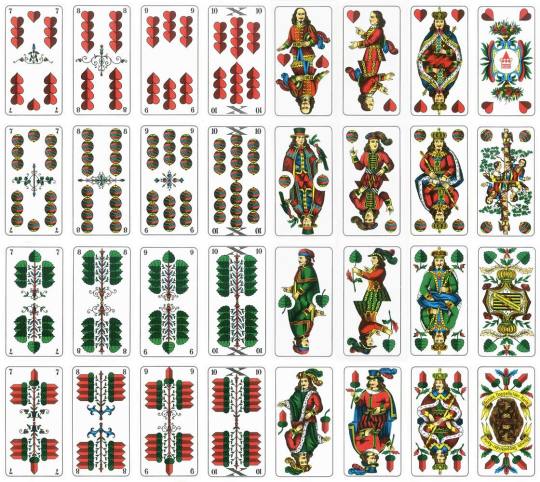
Saxon pattern

Polish-Silesian pattern for the game of Skat

Altenburg Doppelkopf pattern, exhibiting the North German pattern court cards of König-Dame-Bauer with the Germanic suits

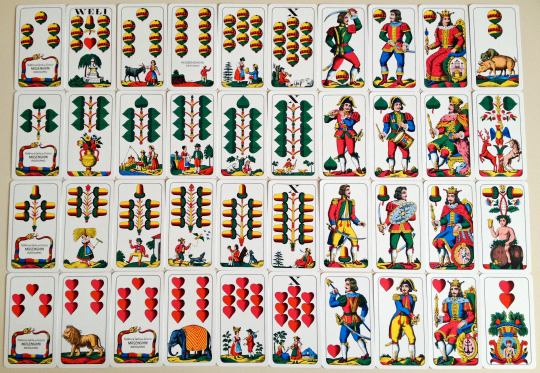
Salzburg pattern showing non-reversible court cards typical of earlier patterns, and Franconian pattern showing reversible ones, typical of later patterns
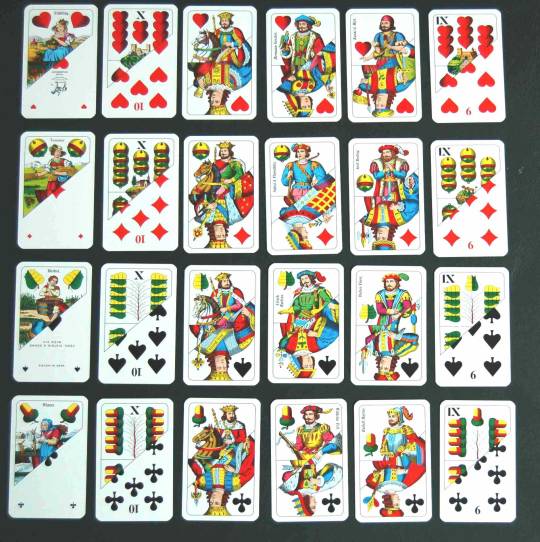
A hybrid deck showing both Germanic and French suits, in this instance the Germanic pattern is listed as William Tell and the French as Viennese
Italian patterns
Italian patterns closely resemble Mameluk and Spanish patterns, and it is in Italy where the polo baton of the Mameluk deck was replaced with a staff, or baton or club, for an area where polo was not well known or played.
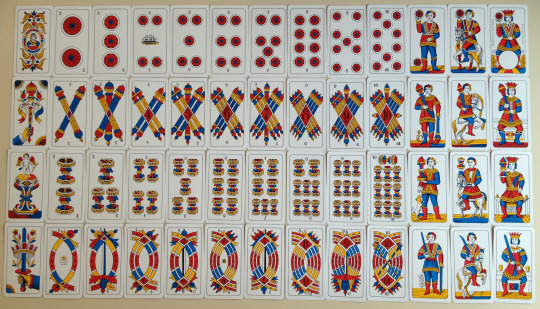
Trentine pattern, showing the Mameluk influence in both suits and court cards (King-Knight-Page)
In South Tyrol, a region acquired by Italy at the First World War, the Germanic Salzburg pattern is still used with Italian translations known as the Salisburghesi pattern.
It was in Italy that the first tarot decks were produced, where additional ‚trumps‘, known in Italian as trinofi, were added for more advanced card games. Typical to Northern Italy in the Italian suits, tarot cards for games such as Tarrochi, Tarock, and Scarto spread to France and Germanic areas whereupon there was further alterations made.
Tarot patterns
Tarot cards were never originally intended for Cartomancy, such associations came later in the 18th and 19th centuries, however there is a distinct split between Franco-Italian patterns and Germanic ones. A rare Italian deck serving as a progenitor of sorts to later 78-card tarot decks that now lost, was described in a letter from Milan in 1449 and supposedly consisted of a deck of 60 cards with only the four Kings as court cards, sixteen trump cards, and the suits as birds rather than any surviving system. Early 78-card decks replaced the court cards with classical figures and made the trump cards those of classical deities. Many of these early decks survive only as incomplete examples, damaged printing sheets, or in descriptions alone.
The Tarot of Marseilles is likely the first 78-card tarot deck to resemble the one we know today. The suits follow the Italian and Spanish patterns, synthesises the French and Spanish-Italian-Mameluk courts cards to give four in each suit: King-Queen-Knight-Page. The Major Arcana, or the trumps when ranked by value, are similar to modern tarot decks, albeit with some notable differences: the Magician is replaced by Le Bateleur (The Juggler), the High Priestess by Le Pances (The Popess, likely a reference to the myth of Pope Joan), and the Hierophant with Le Pape (The Pope). In Swiss tarot decks, the High Priestess is replaced by the classical deity Juno, and the Hierophant with Jupiter, in the style of the older historical Tarot de Besançon pattern.
Germanic tarot cards, however, are entirely different in nature. Trump cards in the Bourgeois Tarot pattern, with its sub-pattern the Tarot Nouveau, depict scenes rather than figures, and are split into groups of four (such as the times of day and the four elements), with the final three depicting Games (trump 20), the Collective (trump 21), and the Individual (trump 1)

Example Tarot Nouveau trumps, reversible but each scene depicting the card’s meaning

The trumps of the Industrie und Glück pattern, a standard tarot deck for games in the Germanic regions that uses the French suit system for value and court cards
One variation of tarot decks, known as Animal Tarot patterns, uses both real and fictional animals for the trump cards, and continues today only in the south German Adler Cego pattern
The End?
Honestly, this is all I have energy for at the moment, but I wanted to show just a hint of the huge variety of different playing card designs throughout the centuries and their effect on the modern decks of today. There is so much more I’d like to get into, so if you have some questions please please please ask!
36 notes
·
View notes
Text
Pres Carter & the Road Not Taken
On June 20, 1979, the Carter administration installed 32 panels designed to harvest the sun's rays and use them to heat water.
Here is what Carter predicted at the dedication ceremony:
"In the year 2000 this solar water heater behind me, which is being dedicated today, will still be here supplying cheap, efficient energy…. A generation from now, this solar heater can either be a curiosity, a museum piece, an example of a road not taken or it can be just a small part of one of the greatest and most exciting adventures ever undertaken by the American people."
For some of the solar panels it is the former that has come to pass: one resides at the Smithsonian's National Museum of American History, one at the Carter Library and, as of this week, one will join the collection of the Solar Science and Technology Museum in Dezhou, China. Huang Ming, chairman of Himin Solar Energy Group Co., the largest manufacturer of such solar hot water heaters in the world, accepted the donation for permanent display there on August 5. After all, companies like his in China now produce some 80 percent of the solar water heaters used in the world today.
But they are based on the same technology developed here in the U.S. and once manufactured in Warrentown, Va., by InterTechnology/Solar Corp., the company behind the Carter panels. Roughly three meters long, one meter wide and just 10 centimeters deep, the blue-black panels absorb sunlight to heat water piped through their innards. The Carter administration set a goal of deriving 20 percent of U.S. energy needs from such renewable sources by the turn of the century. Today, the U.S. gets a mere 7 percent of its energy from renewables, the bulk of that from the massive hydroelectric dams constructed in the middle of the 20th century. Solar thermal and photovoltaic technology combined provide less than 0.1 percent.
[Note: this article was written in 2010; by the end of 2023 the figures were a respectable 21% renewables, 3.9% from solar and 10.1% from wind. ]
By 1986, the Reagan administration had gutted the research and development budgets for renewable energy at the then-fledgling U.S. Department of Energy (DoE) and eliminated tax breaks for the deployment of wind turbines and solar technologies—recommitting the nation to reliance on cheap but polluting fossil fuels, often from foreign suppliers. "The Department of Energy has a multibillion-dollar budget, in excess of $10 billion," Reagan said during an election debate with Carter, justifying his opposition to the latter's energy policies. "It hasn't produced a quart of oil or a lump of coal or anything else in the line of energy."
And in 1986 the Reagan administration quietly dismantled the White House solar panel installation while resurfacing the roof. "Hey! That system is working. Why don't you keep it?" recalls mechanical engineer Fred Morse, now of Abengoa Solar, who helped install the original solar panels as director of the solar energy program during the Carter years and then watched as they were dismantled during his tenure in the same job under Reagan. "Hey! This whole [renewable] R&D program is working, why don't you keep it?"
[...]
It was the oil shock that pretty much caused the government to take a very serious look at its domestic solar resource," recalls Abengoa's Morse, who has spent decades aiding and abetting the still fledgling solar thermal industry both in government and out. "The motivation was energy independence," a motive that remains recognizable in political rhetoric today because, as Carter himself put it, the sun cannot be embargoed, referring to the 1973–74 Arab oil embargo. "We have this big solar resource, we should use it," Morse explains.
Carter was the first president to take that idea seriously, warming the reviewing stand for his inauguration on January 20, 1977 with the sun's heat harvested by roughly 1,000 square meters of solar thermal panels, according to Morse. "President Carter saw [solar] as a really valid energy resource, and he understood it. I mean, it is a domestic resource and it is huge," Morse recalls, although he admits the inaugural solar system left some chilly. "It was the symbolism of the president wanting to bring solar energy immediately into his administration."
That symbolism became more concrete in the form of a vastly increased budget for energy technology research and development (pdf)—levels still unmatched by succeeding administrations—and tax credits for installing wind turbines or solar power that caused a first boom in renewable energy installation. In a sense alternative energy was finally getting the same government support used to develop and maintain other energy technologies, such as oil drilling or nuclear power. "It did not take long for the U.S. government to realize that energy was a great national interest and subsidize it," Morse notes.
But the real symbolism was the Carter family using hot water heated by the sun for some of their daily activities. "It was used for the cafeteria, in the laundry and other parts of the White House," Morse says.
That was symbolism that Morse suggests the Reagan administration did not support as wholeheartedly. "We had a new administration that really did not like renewables very much. I don't know if you remember those days when it was called alternative energy and there was something about 'alternative' that did not sit very well." So when the time came to resurface the roof, the panels were taken down. "It was working fine, but the decision was it was not cost-effective."
[...]
And those solar-thermal collectors also symbolize an alternative history. "We certainly didn't address the oil and energy issues going back to when Carter tried," Tardif says. "Maybe it would be different if Americans understood what actually happened. We were poised to achieve 20 percent renewables by 2000. What happened?"
What happened?
Big Oil's internal scientists concurred with public scientists, predicting global warming creates by fossil fuels, like this 1982 internal document at Exxon corp:

Source:
These projections turned out to be surprisingly accurate, 40 years later.
But Exxon and other fossil fuel companies used hundreds of billions of dollars in taxpayer subsidies to fund a multi-pronged, decades-long disinformation campaign, ranging from funding pro-fossil-fuels politicians to creating fake thinktanks of energy experts to advise news media to subsidizing university programs and professors in exchange for favorable research, as extensively documented by this spring 2024 US Congressional investigation which the press ignored:
This is not simply a history lesson. Trump put sone of his most diligent efforts in his first term into dismantling as much of his predecessor's' signature accomplishments as possible.
Biden's biggest accomplishment is the Infrastructure Act which included aggressive tax breaks, incentives and subsidies for renewables, jobs in the renewables industry, and R&D. Biden got us over the 20% renewables goal Jimmy Carter set.
We cannot afford to let Donald Trump imitate Reagan and put the renewables industry back another 40 years, no matter how many billions of dollars Big Oil gave his campaign.
2 notes
·
View notes
Text
“Iraq, you are in our hearts”

The Awafi Kitchen is where Arab and Jewish cuisine are one. They are part of the Iraqi Jewish community and are based in Boston, USA. All of their family were displaced from Iraq between 1950 and 1970. The following statement and photograph were posted on the Facebook page of the Awafi Kitchen, and was titled ‘Our Return to Iraq’.
“Last month, after five decades away, members of our family finally walked the streets in Baghdad, the city they once called home. Out of hundreds of us in diaspora across the world, we were the first in our family to set foot in Baghdad since our waves of displacement between the 50s and 70s.
The trip was every feeling all at once. Pure joy, gratitude, and reconnection, inextricable from the grief and pain of facing our decades of separation, and seeing much of our family’s hometown deeply changed.
Our whole lives we’ve dreamed of witnessing the beautiful Baghdad we have been painted in memories. We found beauty, but also bore witness to the impact of decades of war, the US occupation, and ongoing resource extraction, and how this has limited the place’s ability to thrive.
That being said, the people we met were incredible. We spent two weeks surrounded by an abundance of love and warmth everywhere we went. There's beautiful new realities rebuilding. Iraqis returning, Iraqis who have stayed through it all.
Tender moments of mutual curiosity and excitement: younger Iraqis eager to learn about the old Baghdad of our family’s youth, the lost Jewish history of the city, and in turn our family eager to learn what it’s like to live as an Iraqi in the contemporary world. And ultimately, as friends reminded us, we accomplished our goal: it was just about touching foot to earth, and that we did.
For any Iraqis considering returning like we did, know that you can count on us for advice or perspective. Don’t hesitate to reach out. And for Iraqis with a reluctance to return, for those who still cannot, we empathize with you. Iraq, you are in our hearts.”
#iraq#iraqi#baghdad#mosul#basra#boston#awafi kitchen#iraqi jews#jewish history#passover#easter#us news#manchester#london#Iraqis#arab american heritage month#arab american national museum#manchester jewish museum#travel#the middle east#synagogue#heritage#jewish heritage#remember baghdad#the wolf of baghdad
31 notes
·
View notes
Text

Meanwhile in American zionist clownland…. Ben Shapiro is a smooth-brained conservative pundit who sounds like Kermit the Frog and has spent his entire life trying to achieve peak stupidity. He's also a fanatical zionist, and justifies his unquestioning support for Israel with profound statements like: "Settlements rock! Israelis like to build - Arabs like to bomb crap and live in open sewage"….
In January 2024, after a high profile visit to the Auschwitz Memorial Museum with Elon Musk, he posted a video in which he said that Jews, Roma, Russian soldiers and homosexuals were killed there, but failed to mention the Polish victims.
Although Auschwitz-Birkenau eventually became an extermination centre in which nearly a million Jews were murdered, the Germans created the camp in 1940 initially for the purpose of interning Polish slavic prisoners, who made up the majority of the inmates until 1942.
According to the Auschwitz Memorial Museum, at least 1.1 million of the 1.3 million people who were deported to Auschwitz-Birkenau died there.
900,000 Jews were murdered in the gas chambers immediately on arrival at the camp.
Of the 400,000 people who were registered as inmates, more than 50% did not survive.
They included 100,000 Jews, 70,000 Polish slavs, 21,000 Roma, 14,000 Soviet POWs and more than 10,000 prisoners of other nationalities, who died as a result of executions, medical experiments, starvation, brutality and disease.
Nobody knows how many LGBT people were deported to Auschwitz or died there, but only a tiny number were sent to the camp specifically for being gay. It's known that at least 77 men with pink triangles were imprisoned in Auschwitz and some scholars speak of up to 140 prisoners persecuted for their sexual orientation.
During their visit, Musk and Shapiro laid a wreath at the reconstructed "wall of death" next to Block 11, where SS men shot several thousand people, nearly all of whom were ethnically Polish - both Auschwitz prisoners and people who had been sent to the camp specifically to be executed, mainly for resistance activities.
It's amazing how often the camp's second largest victim group get erased from Western historical memory, but at least Shapiro didn't refer to Auschwitz as a "Polish concentration camp"….
#ben shapiro#american idiot#elon musk#history#auschwitz#auschwitz-birkenau#concentration camp#german concentration camp#second world war#world war 2#germany#poland#polska#israel#palestine#historical revisionism#bad history takes#bad history take
9 notes
·
View notes
Note
hey dude. . . simple american here. can you tell us some cool awesome whimsical facts about Algeria? :))
OOOOOOOH ANON YOU JUST OPENED THE FLOODGATES
Algeria used to own the strongest navy ever known in the Mediterranean Sea, its power was so big that we used to have full control over the sea, nothing going in nor out without Algerian supervision
Similar to that, Algeria’s navy was so strong it used to tank European powers in battles, we even beat America in a war once
Algeria is full of diverse cultures and races, that includes Arabs, Kabyle, Tuareg, shaoui and much more
Following up to that, Algeria has the nickname of a “continent” given its very diverse landscapes and nature, it has seas and Sahara deserts, it has dunes and it has rock mountains, it has green mountains and green landscapes, it has rivers and it has ponds, it has snowy areas and it has hot areas, every corner of Algeria is like entering a whole new country, but infact you’re still in the same place
Algeria harbours one of the biggest open air museums in the whole world, aka “the Tassili”, which is a Sahara desert area located in the south of Algeria, mostly in the city of Djanet, it is full of beautiful rocks and cave painting that date to thousands of years back
Following up to that, the tassili harbours the oldest rock city “Sefar” that is full of paintings and artefacts that is said to represent tha oldest civilisation in the world
Algeria’s national animal is the fennec fox! Silly lil guy
Algeria’s second president was the first man to ever speak Arabic in the United Nations without interpreting, this was at the times where Arabic was not assigned an official language in the UN
We have a full section in our national anthem that tells France to eat shit and die
Algeria works by a “treat everyone the same way they treat you” system
Algeria is the 10th largest country in the world
It was an Algerian man that put Arabic in computers for the first time ever
Back during the October wars with the Zionist entity Israel, America sold rigged weapons to Egypt, so Algeria was like “nah fuck that” and went into debt with USSR from the amounts of weapons we bought from them
Back when the earthquakes struck Türkiye, the neighbouring country Syria was also badly horribly affected by the same earthquakes, however no country dared to send aids because America put restrictions against it, Algeria’s response to that was “nah fuck you, I do whatever I want” then proceeded to be the first country to actually step in and send help to Syria as well
It was Algerian human frogs that cleared Egypt’s harbour’s from ocean mines and bombs after the war with the Zionist entity
Algerians take dignity seriously, it’s so serious that if you go to Algeria and offer someone a tip they’d actually be offended that you thought that they were helping you for the money
Algeria is famous for its nickname “the country of the million and a half martyr”, that name is derived from the fact that during our 7 year revolution against France, OVER, one million and a half of people were martyred
Following up from that, during the whole 132 years of occupation, it was actually over 5.6 million people that faced martyrdom, the 1.5 million are only the ones that were victim to the 7 year revolution
When Algerians didn’t have access to weapons they used to actually beat the weapons out of the French authorities
Arbi Ben M’hidi, a famous Algerian martyr and figure, was so brave and held into his beliefs so tightly to the point he earned the respect of a French general that was supervising him, not that we need his fucking respect
“What is taken by force is only returned by force” is a famous quote in Algeria that stems from the massacres of 8th of may 1945 where over 45.000 Algerian people were murdered in one day
Little Omar aka Omar yacef is a brave 13 year old boy that used to work for the FLN and as their messenger, he was very brave and is a huge figure in our country, may he rest in peace
Following up to that, Saadi yacef, Omar’s uncle, was one of the FLN heads in Algiers, he managed to live past the revolution and survived to play his own character in the movie about the Algerian revolution, ���the battle of Algiers” movie, he also managed to live to the point of seeing a whole hospital be built in the name of his brave nephew in 2014
Algerians have a fuck around and find out mentality, due to all the humiliation we endured for 132 years, we refuse to take any shit any longer
An Algerian’s favourite question is “where are you from”
Algeria once upped the prices of gas so high for France because the president fucked around and had to find out, he had to come over all the way to Algeria to negotiate about this situation
Algerians also go by a “im getting myself out of this hole, I don’t need nobody” mentality, cause for years so many countries turned their backs on us, most notably the dark decade
The dark decade is a time period from 1991 to 2002, where a civil war broke out and terrorism was all around the country, due to that, all countries closed their borders with algeria and called us terrorists and all (except Libya god bless and save our brothers there) so we really didn’t receive any outside help with isis, we had to fight them off on our own, we clawed our way out of that hole ourselves
Similar to that, when extreme forest fire struck algeria a few years back, only few countries offered aid to the destroyed cities, it was Algeria’s own citizens from other cities that donated money, food, clothes etc etc to the affected cities, showcasing the solidarity between our people
Algeria actually had many major resistances before the 1st of November revolution, the most notable one being the emirates of Abdul kader, they really made France run for its money, tho they all failed due to them being separate and all of the resistances dying with their leaders (not all the leaders were killed but still, the resistances stopped when the leader was stopped)
Speaking of Amir Abdul kader, after his resistance was stopped, he was exiled to Syria, there he had managed to actually save the lives of so many Christian folk from murder despite him being a fully Muslim man
Algeria actually had a decent Jewish population, however when France came along they found a way to separate Muslims and jews by giving jews full citizenship while leaving Muslims to eat dust and be their slaves, so when Algerians gained independence they kicked out anyone with a French citizenship, which included the Algerian jews with the citizenship, that resulted in Algeria’s Jewish population to get smaller and smaller as most of them left with the French, leaving Algeria a country that’s 99% muslim
Algeria actually suggested to cut off all gas and petrol on America and Europe to the Arabs a few days ago as a way to peer pressure the west into calling for a ceasefire on Gaza, unfortunately some Arabs countries voted against it
These are the things I could name on the top of my head, hope you enjoyed this silly infodump
18 notes
·
View notes
Text



Political posters, circa. 1974-1975.
Poster 1: Military Solidarity between Cyprus and Palestine, 1975.
Arabic translation: “Militant solidarity between the Palestinian and Cypriot peoples” Greek translation: “Fighting Solidarity of the Palestinian people to the Cypriot people”
Poster 2: “We do not forget the Cypriot people, victims of the American imperialism”
Poster 3: “Middle East - Chile - Cyprus,” satirical Poster that comments on US foreign policy and intervention.
Image sources and information provided by the Palestinian Poster Project Archives and the National Historical Museum of Greece.
#cyprus#cypriot#cyprus history#cypriot history#cypriot posters#history#anti imperialism#decolonization#unite cyprus#cypriot archive#cyprus archive#free palestine#palestine archive#palestine poster project
6 notes
·
View notes